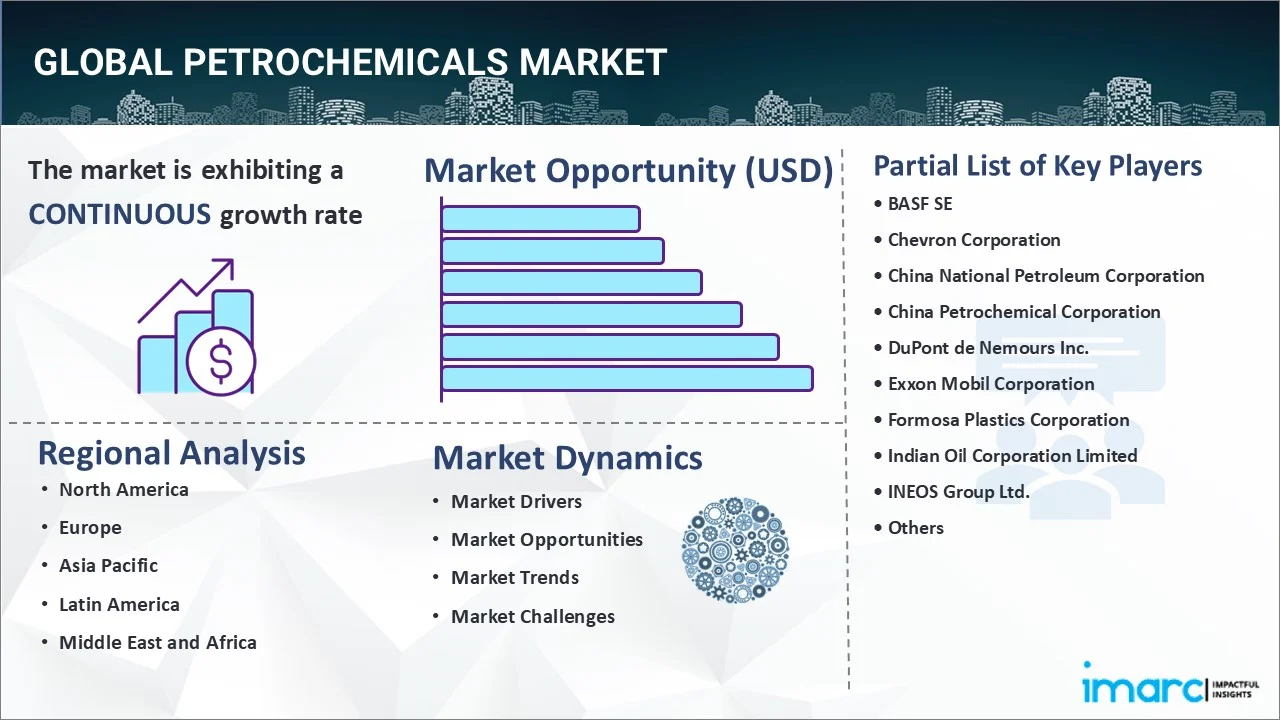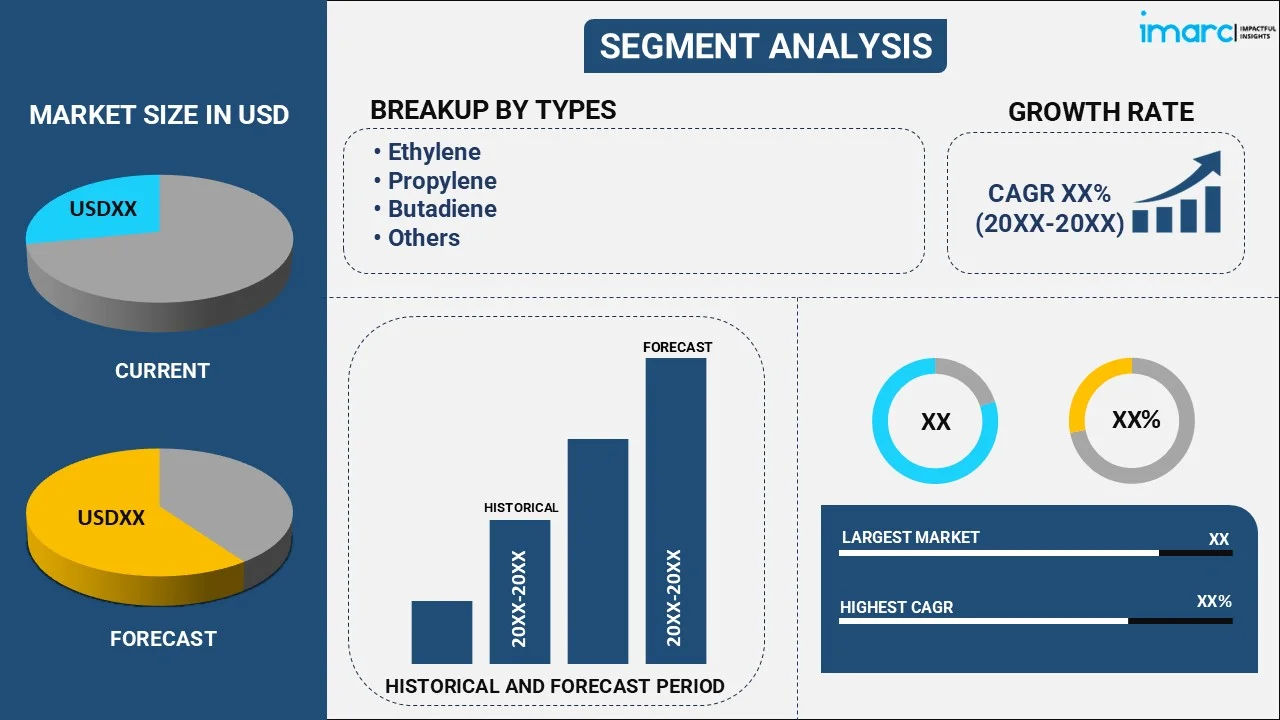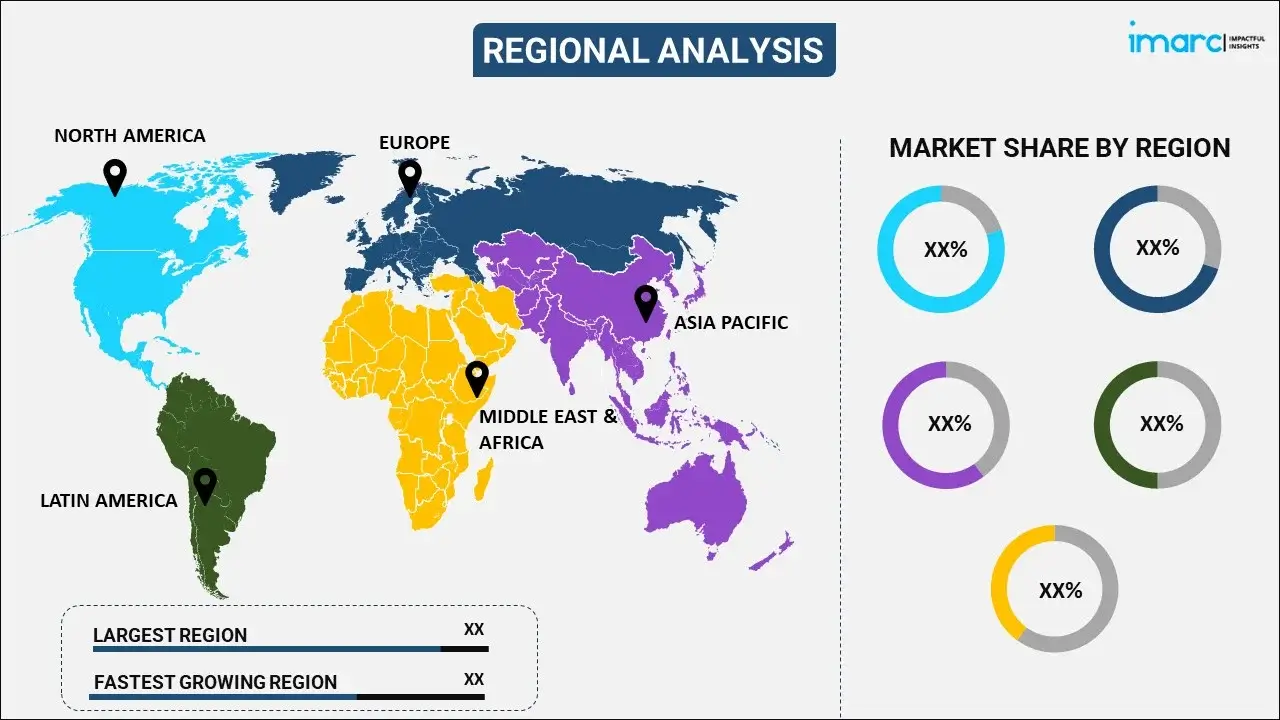
Petrochemicals Market Report by Type (Ethylene, Propylene, Butadiene, Benzene, Toluene, Xylene, Methanol, and Others), Application (Polymers, Paints and Coatings, Solvents, Rubber, Adhesives and Sealants, Surfactants and Dyes, and Others), End Use Industry (Packaging, Automotive and Transportation, Construction, Electrical and Electronics, Healthcare, and Others), and Region 2026-2034
Petrochemicals Market Overview:
The global petrochemicals market size reached USD 675.7 Billion in 2025. Looking forward, IMARC Group expects the market to reach USD 996.1 Billion by 2034, exhibiting a growth rate (CAGR) of 4.40% during 2026-2034. Fluctuations in crude oil prices are influencing production costs and pricing strategies. The escalating demand from industries like automotive, construction, and packaging, along with stringent environmental regulations and sustainability concerns, and advancements in technology, are propelling the market growth.
|
Report Attribute
|
Key Statistics
|
|---|---|
|
Base Year
|
2025 |
|
Forecast Years
|
2026-2034
|
|
Historical Years
|
2020-2025
|
| Market Size in 2025 | USD 675.7 Billion |
| Market Forecast in 2034 | USD 996.1 Billion |
| Market Growth Rate (2026-2034) | 4.40% |
Petrochemicals Market Analysis:
- Major Market Drivers: Global crude oil price fluctuations directly affect production costs and pricing strategies in the petrochemical sector, influencing the market growth. The surging demand for petrochemical products across diverse industries also represent the key factors driving the market growth.
- Key Market Trends: The shift toward sustainability, with increasing emphasis on reducing environmental impact and developing eco-friendly alternatives to traditional petrochemical products, is shaping innovation, regulatory compliance, and market offerings in the sector.
- Geographical Trends: The Asia Pacific region dominates the petrochemicals market, driven by rapid urbanization, industrialization, and the expanding middle class. Technological advancements and strategic investments in infrastructure and industrial capabilities are further driving growth.
- Competitive Landscape: Some of the major market players in the petrochemicals industry include BASF SE, Chevron Corporation, China National Petroleum Corporation, China Petrochemical Corporation, DuPont de Nemours Inc., Exxon Mobil Corporation, Formosa Plastics Corporation, Indian Oil Corporation Limited, INEOS Group Ltd., LyondellBasell Industries N.V., Reliance Industries Limited, Saudi Basic Industries Corporation (Saudi Arabian Oil Co.), Shell plc, Sumitomo Chemical Co. Ltd., and TotalEnergies SE, among many others.
- Challenges and Opportunities: The sector faces challenges such as volatility of raw material prices and stringent environmental regulations. On the other hand, innovation in sustainable practices and materials represent the key opportunities for market players.

To get more information on this market Request Sample
Petrochemicals Market Trends/Drivers:
Fluctuations in crude oil prices
The global petrochemicals market is influenced by changes in the price of crude oil, the primary feedstock for these products, as fluctuations in the prices of crude oil directly impact petrochemical production costs and profitability. In 2012, the crude oil price per cubic meter was about US$ 702 and decreased to about US$ 637 per cubic meter in 2022 (Energy Institute and Our World in Data). When oil prices rise, it often leads to increased production costs for petrochemical manufacturers, which can result in higher prices for end products. Conversely, during periods of lower oil prices, production costs tend to decrease, potentially leading to more competitive pricing.
Furthermore, global organizations also affect oil prices by influencing supply and demand. For example, the Organization of the Petroleum Exporting Countries, or the OPEC can establish production levels for its members. In 2021, OPEC members owned 72% of the proved crude oil reserves and 37% of the crude oil production. These factors underscore the need for petrochemical companies to closely monitor and adapt to changing oil market conditions. Moreover, it highlights the importance of risk management strategies, such as hedging, to mitigate the adverse effects of price volatility.
Surging product demand across industries
The demand from various sectors, including automotive, construction, and packaging is influencing the global petrochemicals market outlook. In the automotive industry, petrochemicals are crucial for manufacturing plastics, rubber, and synthetic fibers used in vehicle components. In packaging, on the other hand, plastics derived from petrochemicals are used for creating lightweight, durable, and cost-effective packaging solutions. At present, plastic packaging accounts for more than 17% of the global petrochemical production as per the Rocky Mountain Institute (RMI). Similarly, the construction sector relies on petrochemicals for materials like PVC pipes and insulation. According to Deloitte Insights, the US market for advanced construction petrochemicals could grow by 32% by 2025. Advanced economies, like the United States and Europe, use up to 20 times as much plastic as developing economies, like India and Indonesia
Environmental regulations and sustainability concerns
As both governments and consumers push for cleaner and more sustainable practices in the petrochemicals industry, companies are under pressure to reduce their environmental footprint, minimize greenhouse gas emissions, reduce energy consumption, and develop eco-friendly alternatives to traditional petrochemical products. To comply with stringent regulations and the adoption of sustainable practices, companies in the petrochemical sector are investing in research and development (R&D) activities to innovate and create greener solutions while also ensuring that their operations adhere to evolving environmental standards. For instance, Sumitomo Chemical, a major Japanese chemical company, is establishing a new, environmentally-friendly method for producing propylene directly from ethanol. The company is building a pilot plant to test the technology as a Green Innovation Fund Project, which is expected to be commercialized by 2025.
Petrochemicals Industry Segmentation:
IMARC Group provides an analysis of the key trends in each segment of the global petrochemicals market report, along with forecasts at the global, regional, and country levels for 2026-2034. Our report has categorized the market based on type, application, and end use industry.
Breakup by Type:

To get detailed segment analysis of this market Request Sample
- Ethylene
- Propylene
- Butadiene
- Benzene
- Toluene
- Xylene
- Methanol
- Others
Ethylene represents the leading petrochemical type
The report has provided a detailed breakup and analysis of the market based on the type. This includes ethylene, propylene, butadiene, benzene, toluene, xylene, methanol, and others. According to the report, ethylene represented the largest segment.
The global production capacity of ethylene was 223.86 million metric tons in 2022, and is influenced by the fluctuations in crude oil prices. The demand for ethylene is reliant on various downstream industries as well, such as plastics, chemicals, and packaging materials, which fluctuates with growth in these downstream sectors or shifts in consumer preferences.
Environmental regulations and sustainability concerns are driving the demand for greener and more sustainable practices, which are encouraging innovation in ethylene production processes and the development of eco-friendly derivatives. For instance, a team of researchers led by a University of Cincinnati professor developed a more efficient way to turn carbon dioxide, a greenhouse gas, into ethylene using a special copper catalyst to improve the conversion process. Such technological advancements in ethylene production also play a significant role in improving efficiency and cost-effectiveness.
Breakup by Application:
- Polymers
- Paints and Coatings
- Solvents
- Rubber
- Adhesives and Sealants
- Surfactants and Dyes
- Others
Polymers dominate the market
The report has provided a detailed breakup and analysis of the market based on the application. This includes polymers, paints and coatings, solvents, rubber, adhesives and sealants, surfactants and dyes, and others. According to the report, polymers represented the largest segment.
The increasing demand for lightweight and durable materials across the automotive, packaging, and construction industries is driving the growth of the polymers segment. The global plastic polymer production reached 460 million ton per year in 2019, doubling from 2000 output. As per the Global Plastics Outlook by OECD, it is anticipated to almost triple from 2019 levels by 2050. The versatility of polymers in creating a wide range of products, ranging from plastics to synthetic fibers, makes them indispensable in modern manufacturing.
Environmental concerns are also influencing the adoption of sustainable and bio-based polymers, driven by stringent regulations and consumer preferences for eco-friendly alternatives. In 2023, an estimated 2.2 million tons of bioplastic was produced worldwide and it is projected to reach 7.4 million tons in 2028, as per findings by European Bioplastics e.V.
Advancements in polymer chemistry and manufacturing processes are enhancing product quality and expanding application possibilities. Research and development (R&D) efforts are driving innovation in polymers, creating opportunities for novel materials with improved properties. Economic conditions and global trade are also influencing supply chains and pricing strategies.
Breakup by End Use Industry:
- Packaging
- Automotive and Transportation
- Construction
- Electrical and Electronics
- Healthcare
- Others
The report has provided a detailed breakup and analysis of the market based on the end use industry. This includes packaging, automotive and transportation, construction, electrical and electronics, healthcare, and others.
Breakup by Region:

To get more information on the regional analysis of this market Request Sample
- North America
- United States
- Canada
- Asia-Pacific
- China
- Japan
- India
- South Korea
- Australia
- Indonesia
- Others
- Europe
- Germany
- France
- United Kingdom
- Italy
- Spain
- Russia
- Others
- Latin America
- Brazil
- Mexico
- Others
- Middle East and Africa
Asia Pacific exhibits a clear dominance, accounting for the largest petrochemicals market share
The market research report has also provided a comprehensive analysis of all the major regional markets, which include North America (the United States and Canada); Europe (Germany, France, the United Kingdom, Italy, Spain, Russia, and others); Asia Pacific (China, Japan, India, South Korea, Australia, Indonesia, and others); Latin America (Brazil, Mexico, and others); and the Middle East and Africa. According to the report, Asia Pacific accounted for the largest market share.
The growth in the Asia Pacific region is driven by rapid urbanization and population expansion, which has spurred demand for infrastructure development, housing, and consumer goods, leading to increased industrial activity and investment. The burgeoning middle class in the region is driving consumerism, creating demand for products and services across diverse industries. As per the UNDP, the middle-class population in the region is projected to comprise two-thirds of the global middle class by 2030. The Asia Pacific has an expanding tech ecosystem, with countries like China and India emerging as global tech hubs, attracting investment and fostering innovation. Favorable government policies, trade agreements, and foreign direct investment are furthermore driving economic expansion. The region's strategic geographical location makes it a key player in global trade, benefiting from the growth of international commerce. The market is also being supported by expanding demand for petrochemicals in the region. In China, for instance, the demand for petrochemical feedstocks was much higher in 2023 than in 2019 as per the International Energy Agency (IEA). On the other hand, India is investing in expanding its refining capacity on account of the rising demand fuel and petrochemicals, driven by rapid economic growth in the country.
Competitive Landscape:
- The global petrochemicals market is highly competitive with intense rivalry among key industry players. The leading companies engage in continuous research and development (R&D) efforts to innovate and introduce new, high-value products, as well as investments in advanced technologies to enhance production efficiency. Companies also focus on diversifying their product portfolios to cater to a broad spectrum of industries and end-users, reducing reliance on established market segments.
- Sustainability measures including the creation of environmentally friendly replacements and compliance with strict environmental policies are critical factors in determining competitiveness. Furthermore, business partnerships, acquisitions, and mergers have a vital impact on expanding market access and competition. A case in point was the signing of the agreement between QatarEnergy, a state-owned petroleum company of Qatar, and Chevron Phillips Chemical Company LLC, a petrochemical company jointly owned by Chevron Corporation and Phillips 66 in the United States, to construct the Ras Laffan Petrochemicals Complex for $6 billion.
- The market research report has provided a comprehensive analysis of the competitive landscape in the market. Detailed profiles of all major companies have also been provided. Some of the major market players in the petrochemicals industry include BASF SE, Chevron Corporation, China National Petroleum Corporation, China Petrochemical Corporation, DuPont de Nemours Inc., Exxon Mobil Corporation, Formosa Plastics Corporation, Indian Oil Corporation Limited, INEOS Group Ltd., LyondellBasell Industries N.V., Reliance Industries Limited, Saudi Basic Industries Corporation (Saudi Arabian Oil Co.), Shell plc, Sumitomo Chemical Co. Ltd., TotalEnergies SE, etc.
(Please note that this is only a partial list of the key players, and the complete list is provided in the report.)
Recent Developments:
- China Petroleum & Chemical Corporation (Sinopec) set up a new unit in September 2023 to invest in overseas petrochemical and refining assets. The new company, known as Sinopec Overseas Investment Holding, is an effort by Sinopec to use its resources and experience to expand internationally as domestic oil demand in China approaches a point of saturation.
- Saudi Aramco announced an agreement with North Huajin Chemical and Panjin Xincheng in March 2023 to begin construction of a petrochemical and refinery complex in Liaoning province in China.
- India's Hindustan Petroleum Corp (HPCL) announced its plans to start its 9 million ton-a-year Barmer refinery and petrochemical project in Rajasthan state by January 2024.
Petrochemicals Market Report Scope:
| Report Features | Details |
|---|---|
| Base Year of the Analysis | 2025 |
| Historical Period | 2020-2025 |
| Forecast Period | 2026-2034 |
| Units | Billion USD |
| Scope of the Report | Exploration of Historical Trends and Market Outlook, Industry Catalysts and Challenges, Segment-Wise Historical and Predictive Market Assessment:
|
| Types Covered | Ethylene, Propylene, Butadiene, Benzene, Toluene, Xylene, Methanol, Others |
| Applications Covered | Polymers, Paints and Coatings, Solvents, Rubber, Adhesives and Sealants, Surfactants and Dyes, Others |
| End Use Industries Covered | Packaging, Automotive and Transportation, Construction, Electrical and Electronics, Healthcare, Others |
| Regions Covered | Asia Pacific, Europe, North America, Latin America, Middle East and Africa |
| Countries Covered | United States, Canada, Germany, France, United Kingdom, Italy, Spain, Russia, China, Japan, India, South Korea, Australia, Indonesia, Brazil, Mexico |
| Companies Covered | BASF SE, Chevron Corporation, China National Petroleum Corporation, China Petrochemical Corporation, DuPont de Nemours Inc., Exxon Mobil Corporation, Formosa Plastics Corporation, Indian Oil Corporation Limited, INEOS Group Ltd., LyondellBasell Industries N.V., Reliance Industries Limited, Saudi Basic Industries Corporation (Saudi Arabian Oil Co.), Shell plc, Sumitomo Chemical Co. Ltd., TotalEnergies SE., etc. |
| Customization Scope | 10% Free Customization |
| Post-Sale Analyst Support | 10-12 Weeks |
| Delivery Format | PDF and Excel through Email (We can also provide the editable version of the report in PPT/Word format on special request) |
Key Benefits for Stakeholders:
- IMARC’s industry report offers a comprehensive quantitative analysis of various market segments, historical and current market trends, market forecasts, and dynamics of the petrochemicals market from 2020-2034.
- The research report provides the latest information on the market drivers, challenges, and opportunities in the global petrochemicals market.
- The study maps the leading, as well as the fastest-growing, regional markets. It further enables stakeholders to identify the key country-level markets within each region.
- Porter's five forces analysis assist stakeholders in assessing the impact of new entrants, competitive rivalry, supplier power, buyer power, and the threat of substitution. It helps stakeholders to analyze the level of competition within the petrochemicals industry and its attractiveness.
- Competitive landscape allows stakeholders to understand their competitive environment and provides an insight into the current positions of key players in the market.
Key Questions Answered in This Report
The global petrochemicals market was valued at USD 675.7 Billion in 2025.
We expect the global petrochemicals market to exhibit a CAGR of 4.40% during 2026-2034.
The widespread utilization of petrochemicals in manufacturing paints, industrial de-greasers, odorless thinners, etc., owing to their cost-effective, durable, and lightweight properties, is primarily driving the global petrochemicals market.
The sudden outbreak of the COVID-19 pandemic had led to the implementation of stringent lockdown regulations across several nations resulting in the temporary closure of numerous end use industries for petrochemicals.
Based on the type, the global petrochemicals market has been segmented into ethylene, propylene, butadiene, benzene, toluene, xylene, methanol, and others. Among these, ethylene represents the largest market share.
Based on the application, the global petrochemicals market can be bifurcated into polymers, paints and coatings, solvents, rubber, adhesives and sealants, surfactants and dyes, and others. Currently, polymers account for the majority of the total market share.
On a regional level, the market has been classified into North America, Europe, Asia-Pacific, Middle East and Africa, and Latin America, where Asia-Pacific currently dominates the global market.
Some of the major players in the global petrochemicals market include BASF SE, Chevron Corporation, China National Petroleum Corporation, China Petrochemical Corporation, DuPont de Nemours Inc., Exxon Mobil Corporation, Formosa Plastics Corporation, Indian Oil Corporation Limited, INEOS Group Ltd., LyondellBasell Industries N.V., Reliance Industries Limited, Saudi Basic Industries Corporation (Saudi Arabian Oil Co.), Shell plc, Sumitomo Chemical Co. Ltd., and TotalEnergies SE.
Need more help?
- Speak to our experienced analysts for insights on the current market scenarios.
- Include additional segments and countries to customize the report as per your requirement.
- Gain an unparalleled competitive advantage in your domain by understanding how to utilize the report and positively impacting your operations and revenue.
- For further assistance, please connect with our analysts.
 Request Customization
Request Customization
 Speak to an Analyst
Speak to an Analyst
 Request Brochure
Request Brochure
 Inquire Before Buying
Inquire Before Buying




.webp)




.webp)












